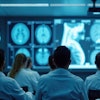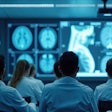SAN DIEGO - You win some, you lose some. The results of the American College of Radiology's recent legislative activities have been decidedly mixed, senior ACR executives concluded Tuesday at the Radiology Business Management Association (RBMA) meeting.
Dr. James Borgstede, chairman of the ACR's Board of Chancellors, and Pam Kassing, senior director of health policy, discussed the Reston, VA-based society's efforts over the past year to strike a better deal for radiology on issues like tort reform, physician self-referral, and insurance reimbursement.
Borgstede said the ACR has ramped up its efforts to influence public policy in Washington, DC, in particular by opening an office in the capital to spearhead its government relations programs. The society has hired additional government relations staff and third-party lobbyists, and increased its interaction with government agencies, he said.
The society's main priorities right now include tort reform, introducing physician self-referral legislation, and changes to the Medicare conversion factor that determines physician reimbursement.
With respect to tort reform, the ACR has been working with the American Medical Association in attempting to secure a federal cap on pain and suffering awards. Although three attempts have been made, all have failed due to opposition from Democrats in the House of Representatives, who have prevented legislation from coming to a vote, Borgstede said. It is unlikely that any tort reform bill will be enacted in the near future, unless supporters are able to secure the supermajority in the House that is necessary to close debate on the issue.
Curbing physician self-referral
The ACR's activities in securing self-referral legislation are more promising. Studies have indicated that non-imaging specialists are behind a skyrocketing increase in imaging utilization that has occurred between 1992 and 1999, Borgstede said. Two modalities -- MRI and nuclear medicine -- have seen particularly high growth rates, with utilization of MRI by non-imaging physicians up 250%, and nuclear medicine utilization growing 207% by non-imaging specialists, versus a 2% decrease for radiologists. Mammography was the only area where radiologists increased their utilization rates as non-imaging utilization fell.
"Where there is no money, there is no interest (by non-imaging physicians). Where there is bureaucracy, there is no interest. Where there is litigation, there is no interest," Borgstede said of the mammography situation.
While the Stark I and Stark II laws include some prohibitions on self-referral, they have plenty of loopholes. For example, nuclear medicine and interventional radiology are not covered by the Stark laws, nor are imaging studies conducted by physicians in their own offices.
Unlike on tort reform, radiology has few friends among other medical specialties who believe that self-referral is a problem worth fixing. "The realities of self-referral are that we are alone. No one else in medicine feels that this is a particular problem, because they are doing self-referral. And they enjoy it," Borgstede said.
But radiology does have a few allies in the self-referral fight. Congress and insurance payors are becoming increasingly concerned about rising costs due to self-referral, and the ACR also has some facts on its side. The society’s data indicate that the Centers for Medicare and Medicaid Services (CMS) could save $6 billion over the course of 10 years by reining in self-referral -- and this figure doesn't even include the savings that third-party insurance carriers could realize.
The ACR has been meeting with CMS, as well as third-party carriers, to educate them on the self-referral problem, and to support state legislative efforts such as the strengthening of certificate-of-need (CON) laws. The introduction of federal legislation will have to wait until the presidential election has been completed, as it’s unlikely that the issue could get a fair hearing given the political climate, Borgstede said.
CPT codes and Medicare reimbursement
The ACR has also been involved in efforts to reform the Medicare conversion factor, a multiplier used to determine Medicare physician payments. Radiology -- and other medical specialties -- have been able to avoid annual cuts of as much as 4.2% by pointing out to Medicare flaws in the formula used to calculate the conversion factors. Instead, physicians have received 1.5% increases for 2004 and 2005.
However, a permanent fix has not been made, and healthcare providers could be due for a 10% cut in 2006, as the conversion-factor formula has continued running in the background pending a long-term solution. Providers could have to make up for the years in which they won a reprieve, Borgstede said.
Borgstede finished his section of the talk by calling on RBMA members to join RAD-PACS, the ACR's political action committee. "Your economic viability depends on the college's success," he said. "(The RBMA) is extremely important to me. This is where the rubber meets the road on economics."
Speaking next, Kassing described the ACR's recent efforts to collect practice-expense data in an attempt to stabilize Medicare technical-component payments. Medicare in 1998 was proposing to change its practice-expense values from a cost-based structure to a resource-based structure, and needed data on practice costs to determine the new rates.
The best data at the time was the AMA's Socioeconomic Monitoring Survey, but after reviewing the AMA data, the ACR determined that it didn't accurately reflect costs in radiology, Kassing said. Many practice-expense categories that should have had dollar amounts were in fact empty -- for example, an imaging practice that said it had no expense for supplies.
The survey was sent to RMBA members, and the data-collection period closed in the fall of 2003. The ACR then submitted it to CMS in March, and expects to hear back from the agency in July, when CMS will issue the proposed 2005 Medicare fee schedule. "This next year is going to be critical in negotiating with Medicare how they use that data," Kassing said.
The ACR has also been active in working on new CPT codes for new imaging technologies, one of which is CT colonography (virtual colonoscopy). Two new category III CPT codes will be issued for CTC, one for screening and one for diagnostic, and these codes must be used rather than the separate CT abdominal exam codes that some providers have used in the past. It's still not clear what payment level will be used for the codes, and some payors are still skeptical about the procedure and want more data on its efficacy, Kassing said.
New codes are also on the horizon for PET with and without CT for anatomic localization and attenuation correction, with Medicare replacing the category G temporary codes used in the past with regular category I codes.
The ACR is also working with the AMA on the ACR/AMA Clinical Examples pilot project, an effort to capture codes more accurately by ensuring that they match the impressions listed in the dictation of a report. A product based on the project should be available by January 2005, Kassing said.
By Brian CaseyAuntMinnie.com staff writer
June 9, 2004
Related Reading
ACR censures member for expert testimony, May 20, 2004
ACR bolsters teleradiology statement, May 14, 2004
Copyright © 2004 AuntMinnie.com

















